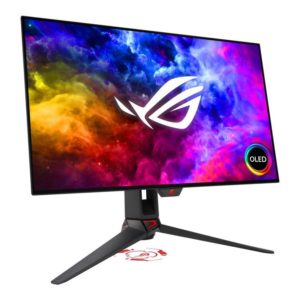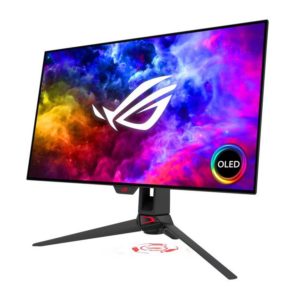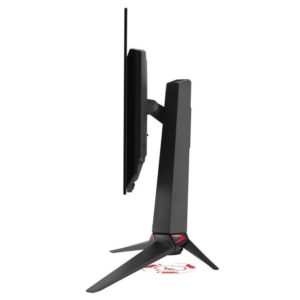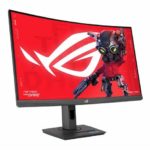











ASUS ROG Swift OLED PG27AQDM 240Hz 1440p OLED 0.03ms G-SYNC Gaming Monitor
₨ 260,000
- 26.5-inch QHD (2560 x 1440) OLED gaming monitor with 240 Hz refresh rate and 0.03 ms response time for immersive gaming
- Highly efficient custom heatsink, plus intelligent voltage optimization for better heat management to reduce the risk of burn-in
- High perceptual 1000 nits peak brightness (3% of the screen with HDR on), 99% DCI-P3 gamut, and Delta E < 2 color difference for astonishing HDR performance
- Optional uniform brightness setting ensures consistent luminance levels
- DisplayWidget Center enables easy OLED and monitor settings adjustments with a mouse
- Two HDMI® 2.0 ports, support for VRR on Xbox Series X and Series S consoles, VRR for PlayStation 5 games that include an unlocked framerate mode
- Description
Description
ASUS ROG Swift OLED PG27AQDM 240Hz 1440p OLED 0.03ms G-SYNC Gaming Monitor Price in Pakistan
| Brand
Name of the company-manufacturer. |
Asus |
| Series
Name of the series, which the model belongs to. |
ROG Swift |
| Model
Designation of the model. |
ROG Swift OLED PG27AQDM |
| Model year
The year in which this model was announced. |
2023 |
Display
Information about the main characteristics of the display – panel, backlight, resolution, refresh rate, etc.
| Size class
Size class of the display as declared by the manufacturer. Often this is the rounded value of the actual size of the diagonal in inches. |
26.5 in (inches) |
| Diagonal
Approximate diagonal size of the display. If the manufacturer does not provide such information, the diagonal is calculated from the width and height of the screen. |
678.2 mm (millimeters) 67.82 cm (centimeters) 26.7008 in (inches) 2.2251 ft (feet) |
| Width
Approximate width of the display. If the manufacturer does not provide such information, the width is calculated from the diagonal and the aspect ratio. |
590.42 mm (millimeters) 59.042 cm (centimeters) 23.2449 in (inches) 1.9371 ft (feet) |
| Height
Approximate height of the display. If the manufacturer does not provide such information, the height is calculated from the diagonal and the aspect ratio. |
333.72 mm (millimeters) 33.372 cm (centimeters) 13.1386 in (inches) 1.0949 ft (feet) |
| Panel manufacturer
Name of the manufacturer of the display panel. |
LG Display |
| Panel type
There are various panel technologies. Each has its own specific features – viewing angles, color reproduction, response time, brightness/contrast, production cost, etc. The image quality depends directly on the type of the display panel used. |
OLED |
| Panel bit depth
The most widely used panels are those with 6, 8, and 10 bits for each of the RGB components of the pixel. They provide 18-, 24-, and 30-bit color, respectively. |
10 bits |
| FRC
Frame Rate Control (FRC) is a method, which allows the pixels to show more color tones. With quick cyclic switching between different color tones, an illusion for a new intermediate color tone is created. For example, by using FRC, a 6-bit display panel is able to show 16.7 millioin colors, which are typical for 8-bit display panels, and not the standard 262200 colors, instead. There are different FRC algorithms. |
No |
| Colors
The maximum number of colors, which the display is able to reproduce, depends on the type of the panel in use and color enhancing technologies like FRC. |
1073741824 colors 30 bits |
| Aspect ratio
The ratio between the horizontal and the vertical side of the display. Some of the standard and widely used aspect ratios are 4:3, 5:4, 16:9 and 16:10. |
1.778:1 16:9 |
| Resolution
Information about the number of pixels on the horizontal and vertical side of the screen. A higher resolution allows the display of a more detailed and of higher quality image. |
2560 x 1440 pixels Quad HD (QHD) / 1440p |
| Pixel pitch
The pixel pitch shows the distance from the centers of two neighboring pixels. In displays, which have a native resolution (the TFT ones, for example), the pixel pitch depends on the resolution and the size of the screen. |
0.229 mm (millimeters) 0.0229 cm (centimeters) 0.009 in (inches) 0.0008 ft (feet) |
| Pixel density
Information of the number of pixels in a unit of length. With the decrease of the display size and the increase of its resolution, the pixel density increases. |
110 ppi (pixels per inch) 43 ppcm (pixels per centimeter) |
| Display area
The percentage of the approximate area, taken by the active part of the screen, to the total front area. |
92.79 % (percent) |
| sRGB
sRGB is a color space, developed jointly by Hewlett-Packard and Microsoft in 1996. It is used in different devices such as printers, displays, TV sets, cameras, etc. The sRGB color space covers about 72% of the NTSC color space. |
100 % (percent) |
| DCI P3
DCI P3 is a color space, introduced in 2007 by the SMPTE. It is used in digital cinema and has a much wider gamut than the sRGB. |
99 % (percent) |
| Brightness
Information about the brightness of the screen. It is measured in candela per square metre (cd/m²). |
240 cd/m² (candela per square meter) |
| Peak brightness
Often even a higher peak luminance can be achieved under certain conditions. For example, when a smaller area/APL of the display is used for showing a bright object, when a bright object is displayed for a short time, etc. |
500 cd/m² (candela per square meter) |
| Static contrast
The static contrast shows the ratio between the brightest and the darkest color, which the display can reproduce simultaneously, for example, within one and the same frame/scene. |
1500000 : 1 |
| HDR
HDR expands the contrast ratio (peak luminance and minimal black levels) and color palette to achieve more details across the whole image – from the darkest parts to the brightest ones, which results in more realistic and life-like image. |
HDR10 |
| Horizontal viewing angle
Information about the maximum horizontal viewing angle, within which the image on the screen is of acceptable quality. |
178 ° (degrees) |
| Vertical viewing angle
Information about the maximum vertical viewing angle, within which the image on the screen is of acceptable quality. |
178 ° (degrees) |
| Minimum response time
Information about the minimum amount of time, in which the pixels change from one color to another. Very often the manufacturer provides the response time for transition from grey-to-grey (G2G). |
0.03 ms (milliseconds) 0.0000 s (seconds) |
| Average response time
Information about the average amount of time, in which the pixels change from one color to another. |
0.8 ms (milliseconds) 0.0008 s (seconds) |
| Maximum response time
Information about the maximum amount of time, in which the pixels change from one color to another. |
1.8 ms (milliseconds) 0.0018 s (seconds) |
| Input lag
Desktop monitors and smart TVs experience a latency/lag in visualizing the information. The time in milliseconds that the display needs to visualize the signal input. |
8.8 ms (milliseconds) 0.0088 s (seconds) |
| Coating
Information about the type of coating of the display. There are different types of matte and glossy coatings, each of which has its own advantages and drawbacks. |
Anti-glare/Matte |
Related Products
-
-
Monitors
EASE G24I20 24-Inch Full HD IPS Panel 165Hz 1ms Gaming Monitor
₨ 34,560Original price was: ₨ 34,560.₨ 33,550Current price is: ₨ 33,550. -








